Cops and Command Presence: What’s Up With That Look?
Predatory animals watch and stalk their prey before moving in for the kill. They’re extremely patient, waiting for the perfect target—the weakest animal in the pack—because the battle is easier.
Criminals often exhibit similar behavior when interacting with law enforcement. The cop who looks and acts weak—the meekest of the herd—often finds himself the target of all sorts of grief, from verbal abuse all the way to physical assault.
So what do cops do as a front line defense against all that unnecessary heartache? Well, for starters, they’re taught to have and demonstrate what’s known as Command Presence.
An officer who looks sharp, acts sharp, and is sharp, has an advantage over the officer who dresses sloppily and isn’t all that confident about their work. The latter are the officers who most often find themselves having the most difficulties on the street.
Command presence is all about being at the top of the game. Taking a few minutes to be sure your shoes, badge, and brass are polished goes a long way toward projecting a positive image. So does wearing a clean and neatly pressed uniform. And let’s don’t forget regular trips to the folks who cut hair for a living. The combination of these things help to make an officer look confident. Think about it … who would you trust more, the officer with the dirty, wrinkled clothing and shaggy hair, or the officer who looks fresh and sharp, stands straight and tall, and projects a solid air of authority?
Crooks size up officers the same way you do. However, they have other things in mind when they do. They, like animals culling the herd, watch, looking for the weaker officers, and those are the officers who’ll most likely be dealing with escape attempts, lies, and other criminal tricks.
Tips for developing a better command presence
- Be professional at all times. And that includes updated training when available. A cop who knows his job inside-out projects more confidence. The same is true with physical training. Stay in shape and know, trust, and practice your defensive tactics.
- Good posture is important. The officer who stands straight and tall has an advantage over the officer who slouches. Poor posture often comes across as weakness, especially when confronting an aggressive suspect.
Captain Randy Shepherd is a textbook example of Command Presence.

NWTC Public Safety Academy and Writers’ Police Academy firearms instructor. Another fine example of Command Presence.
- Always make and maintain eye contact when speaking to someone.
- Honesty and consistency are important traits. Bad guys will quickly learn that what you say is what you mean, each and every time.
- Always treat everyone fairly and with dignity.
- First impressions only come around once, so make it your best effort. If a suspect’s first impression of you is that you’re meek and weak, well, you can expect to have a rough day.
- Size up everyone. Always be aware of who and what you’re dealing with, and stay one step ahead of the person in front of you. Remember, that person may want to kill you so be prepared to do what it takes to survive. Do this each and every time you come into contact with someone. No exceptions! You never know which person is the one who plans to do you harm.
Most importantly, believe in yourself. Have confidence in what you do and who you are. All the shoe-shining and training in the world will not help you if you’re playing make believe. The bad guys will see through that in a heartbeat.
Cops and Command Presence: What’s Up With That Look?
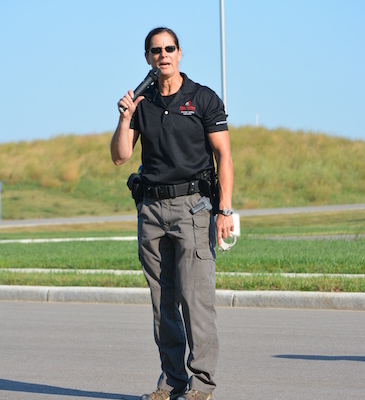
Colleen Belongea – NWTC Public Safety Academy and Writers’ Police Academy instructor, Green Bay PD (ret.), and current co-owner of Assured Private Investigations, a PI firm based in Appleton, Wi. Colleen’s partner,Jill Goffin, is also a NWTC Public Safety Academy and Writers’ Police Academy instructor.
Remember, command presence is only the first step in the “stay safe” equation. Others include:
- Be aware of your surroundings. What can the bad guy use as a weapon? Does he have a friend lurking in the shadows? Do YOU have an escape route, if needed?
- Officers must be prepared, without hesitation, to do what it takes to control a situation. Many times, all that’s needed to gain and maintain control is verbal instruction, and it would be wonderful if a handful of nouns and verbs were the ultimate “fix-all” tools. However, we don’t live in an always-happy world filled only with glitter, delicious chocolate, and smile factories. So, unfortunately, use of force will come into play during an officer’s career … many times.
- Never, ever, be in the position where you’re forced to react after-the-fact to a situation you weren’t prepared to handle. If the situation is one where you absolutely must place your hands on a suspect, then be prepared to see the arrest through until the suspect is in restraints and tucked safely away in the rear compartment of your patrol car.
- When encountering a violent suspect, think ahead and be prepared to increase the level of force used to effectively make the arrest. The idea is not to injure anyone. Instead, the goal is to engage, arrest, and restrain without unnecessary harm to anyone. If the suspect chooses to fight until there is only one person left standing, then be certain that person is you.
- Effective command presence leaves no doubt as to who’s in charge of the situation, even without speaking a single word.
So wear the badge proudly, stand tall, and do what it takes to come home at night.
By the way, civilians in authoritative positions should also exhibit a command presence, and many do so instinctively. Command presence also applies to public speakers, including writers when appearing at conferences and book signings and readings. One of the best in the business at the command presence game is author Lee Child. The moment Child enters a room you know he’s confident, poised, and in full control of each word spoken. He looks sharp, acts sharp, and, well, he is sharp. And it shows.
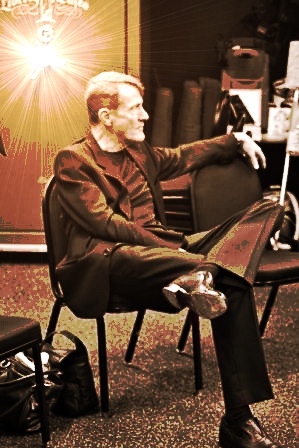
Lee Child – Writers’ Police Academy
Another fantastic example of someone with fantastic command presence is author/former prosecutor Marcia Clark (yes, that Marcia Clark). Clark comes across as a take charge person, always in control no matter the situation.
Marcia Clark addressing the entire group at the Writers’ Police Academy
Both Lee Child and Marcia Clark are confident in what they do, but their personalities are also warm enough to transform even the largest iceberg to a puddle, even at a homicide scene (shallow grave workshop at the 2012 Writers’ Police Academy).
Lee Child and Marcia Clark – shallow grave workshop at the 2012 Writers’ Police Academy
So, you see, having command presence does not necessarily mean a person has to be tough and gruff, but can be when the situation calls for it.
After all, even the toughest of the tough have their tender moments.
GTCC/WPA instructors Stan Lawhorne and Jerry Cooper – Writers’ Police Academy




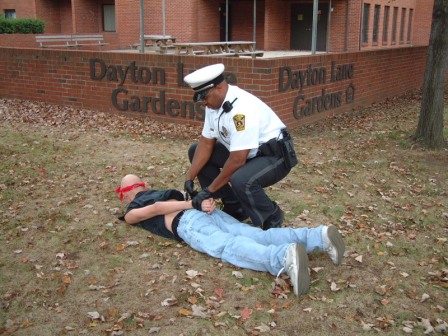
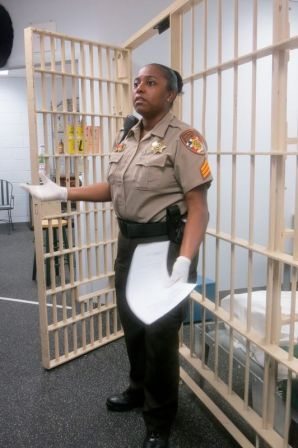


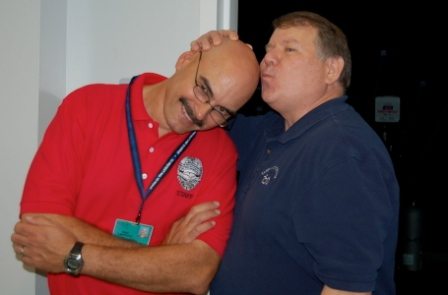
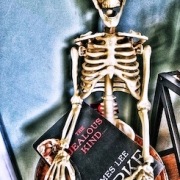




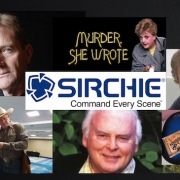
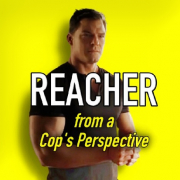




This is why one of the current hot buzzwords trends in our World, ‘de-escalation’ is fairy dust created by Dullards who have no idea of how police work actually works. Offender do judge Cops by the officers’ attitude and are much less like to attack to a veteran Copper with an “I don’t play” way of presenting themselves. De-escalation training teaches the Cop “not to look aggressive on his bodycam video” and to say to the Offender in a neutral tone “is there anything I can say, to get you to step out of your car”. Leaders in Law Enforcement need to be LEADERS and actual tell the Public that real life is not always pretty, and Cops need to speak to Offenders in a way Criminals understand.